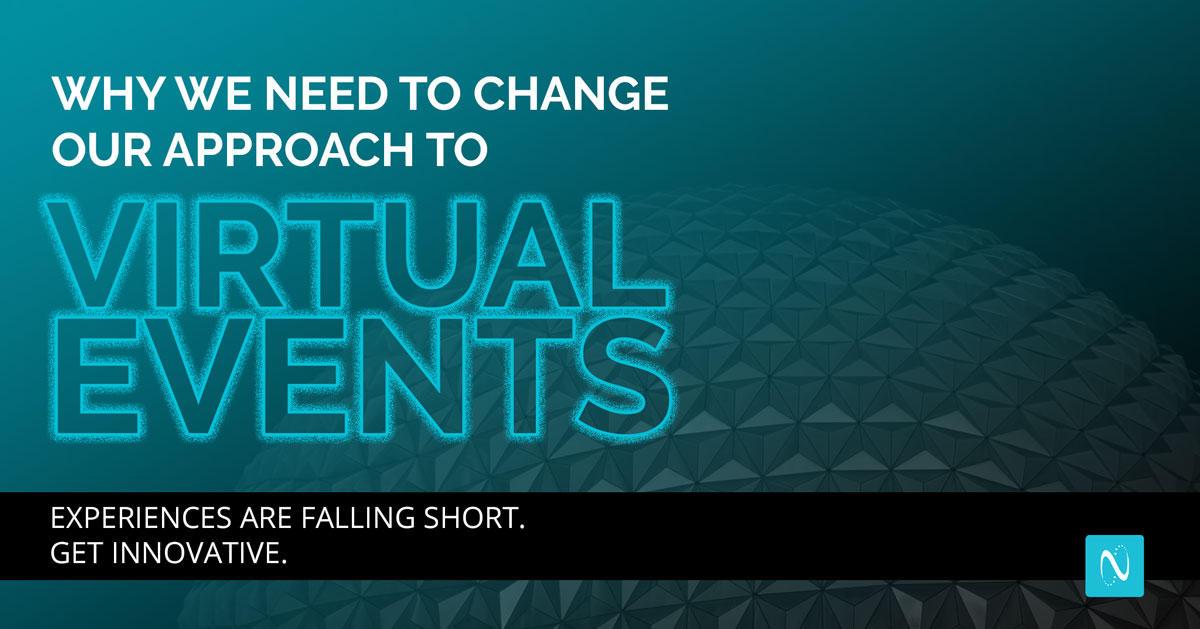When I think of Disney, I think of incredible experiences.
My next-door neighbor is a Disney devotee. Every year, she’ll go on a Disney Cruise or to DisneyWorld (sometimes twice) with her family. The way she describes each trip is remarkable, being sure to detail each moment where a member of the Disney staff enhanced their adventure. It’s enough to make you want to book your own trip.
But not this year.
Like most, I’m not exactly comfortable with the idea of taking my young family into a COVID-hot-bed just to be wowed by the wonders of Walt. The majority of America feels the same way, too, it appears. On October 1st, Disney announced that 28,000 employees would be laid off, illustrating just how widespread the economic ripples of the pandemic go. Brutal.
In a world where experience matters more and more, we find ourselves standing on the edge of a newfound fault line. People still crave experiences — and most are falling short.
New Look, Same Great Experience!
Not too long ago, live events felt like an unending source of new experiences, providing energy and thrills. These events have been one of the biggest casualties of the COVID-19 Pandemic.
Whether you were speaking, sponsoring, or just attending, live events demanded your attention, your energy, and your presence in every way. Going to a live event was something we’d look forward to.
We don’t know when they’ll return or how they’ll look when they do. As so much of our lives have shifted to digital, events have followed suit. But some aspects simply aren’t converting as readily.
Lost in Translation
NetLine is not in the live events business. Having attended hundreds and sponsored dozens more, however, we’re pretty familiar with what works and what doesn’t.
In the current landscape, we continue to see events attempting to retrofit a successful recipe for a live event into a container that’s completely incompatible. What works in-person doesn’t always work over Zoom, which is essentially where every conference now takes place. Conferences are now glorified webinars.
We understand why. All of the data captured during the registration process — a process NetLine has enhanced for thousands of publishers and marketers over the years with our predictive form technology — leads to eventual sales opportunities for the hosts, sponsors, and attendees. Events are a huge piece of the pie for so many companies and punting on an entire year just isn’t feasible.
But we’re living in the Digital-First world. So why are virtual conferences still going after the broadest audience possible?
Divide and Conquer
Scale certainly matters for physical events. In-person conferences cater to thousands of attendees looking to find the solution for their specific challenges. Renting out a convention center isn’t exactly cheap, so event organizers are trying to squeeze every possible registration out of each year. Physical events have a dozen different tracks so that everyone can find something for themselves. It’s in-person segmentation.
We don’t need to do this with virtual events.
Instead, virtual conferences need to better define which audiences they truly serve and get even more granular from there. We have the data to do this, people!
This is an opportunity for your teams to create mini-events for each of these audience segments, accomplishing a myriad of positives:
Limit the Scope
Putting on an event is an insane amount of work. Knowing this, perhaps it’s not ideal to have 8 mini-events in one year.
But the advantage here is clear: you’re not preparing for 8 gigantic, multi-day epics. The events we’re describing are more like beefed-up webinars with a proper agenda, super-relevant speakers, topics, and discussions around the obstacles a given audience has. By tailoring each aspect of the event to one segment, your experience will be irresistible to your targets.
Hyper-Targeting = Hyper-Investment
Have you ever wished that your two favorite musicians would somehow find a way to work together on a song or album…and then it actually happens? It feels too good to be true. It’s something just for you.
This is how prospects and target buyers will feel, too, if they’ve discovered that your company has put together a smaller event catered to the things they care about in their own professional lives.
Refocus Your Content Marketing
2020 destroyed the majority of scheduled content marketing strategies. Wouldn’t it be nice to have a series of tent poles to support in the coming weeks and months? By creating a group of smaller events, your content team can create material that directly promotes the benefits of each session and directly capture first-party, intent-driven registrants right from your site.
Find the Overlap
Generating registration data for a single event often tells you one thing about your users: they’re interested in the general idea of your convention. But what if the same professional signs-up for multiple sessions? Maybe they’re just an infovore, but it’s more likely that their job requires more from them than you’d previously expected.
This gives you additional context for any data you’re feeding into your CRM and provides a greater entree in any future communications with this prospect.
Beyond these examples, the handful of virtual events we have been a part of are clearly missing something else.
One Actionable Idea
Most events, offline or online, have a theme. What they’re often missing, however, is one specific takeaway that their audiences can take back to their businesses and make an immediate impact.
By taking one big event and chunking it up into multiple, more niche experiences, not only are you spreading out your chances to capture more genuine interest throughout the year, you’re also setting the table to present specific conclusions for each segment of your audience. These custom outcomes will be better received and are more likely to be implemented within by your attendees since takeaways will be created with their needs solely in mind.
The Elephant in the Zoom Room
There’s something else on your target prospect’s mind: Cost.
Why would they want to pay big bucks for content they can get from a free webinar? The truth is they don’t and, frankly, aren’t. According to Bizzabo, only 20% of virtual events have required payment with an average ticket going for just $254 as of June 2020 — down from $368 in May and $511 in April.
While the virtual events market is expected to grow ~23.2% from 2020 to 2027, there are still major kinks that need to be worked out. The biggest one for organizers — aside from generating interest in their event — is how they’re going to generate revenue.
NetLine’s Publisher Platform provides virtual events with alternative methods of monetization, specifically during the registration process. Simply by promoting their own content to their own audience, the Platform offers a means to generate revenue (some businesses have earned as much as 6 figures) without doing anything extra. Most publishers leveraging this platform are experiencing a 20% lift in their gated content monetization. That said, there have been a few breakout start performances yielding nearly a 50% lift in revenues associated with their gated content experiences.
Beyond the monetization benefits of the platform, our technology also affords B2B publishers with the ability to tap into on-demand scale beyond their existing audience footprint. Doing so allows them to fulfill the total demand for registrants, meeting the desired attendee volume they may have expected or promised a sponsor. The best part? Publishers only pay for registrants who fit their target criteria on a CPL basis. In a world where virtual events are still finding their footing, NetLine can help you find stability.
Why You’re Better Off Than Disney (For Now)
Photo by Patrick Hunt on Unsplash
Let’s go back to the House of Mouse, quickly.
Disney is one of the richest corporations in the world. While it might be worth asking why they couldn’t bite the bullet to support their employees any longer than they already have, there is one thing that they have to reach in order to be successful: Epic scale.
Where a behemoth like Disney can’t get granular, you can. And that’s a major win for you.
The scale that you need to achieve is so much smaller than what they must attain. This is a wild time in our lives that we certainly hope we will never experience again. But while we’re here, we should take advantage of the opportunity to innovate and make an honest effort to connect with your potential customers in ways that go well beyond the, “well, this is how we’ve always done it.”
Considering “always” in this case would be roughly 7 months, that can’t be true. We can all do better, NetLine included. Let’s break away from the reruns and start innovating together.

